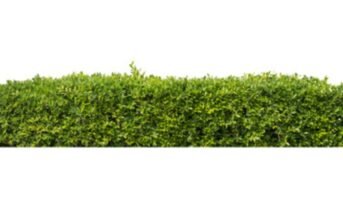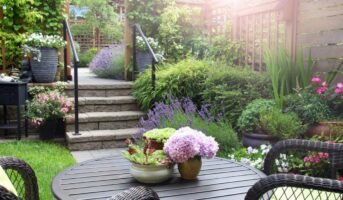The simplicity and serenity of Japanese gardens make them ideal settings for contemplation and relaxation. Consisting largely of evergreens, rocks, pebbles, sand, ponds, and waterfalls, they put the opulence of many Western garden designs to shame. In most cases, the garden’s architecture is spare and unadorned, preferring to let the garden’s natural setting take centre stage. The gardens include weathered and natural features and employ bold colours to depict the changing seasons.
Japanese garden designs often include plants and weathered, aged items to evoke a sense of the natural world and to reflect on the transience of life and the relentless march of time. In the past, Japanese art served as an inspiration for landscape architects. Many gardens also have pebbles and sometimes even gravel, in addition to water. Despite the fact that Japan is home to many beautiful flowering plants, herbaceous flowers play a much smaller role in Japanese gardens than they do in Western gardens. However, flowering shrubs and trees play an important role, especially since they stand out so dramatically against the typically dominant greenery.
See also: What are the medicinal benefits of Camellia Japonica aka Japanese Camellia?
Japanese garden: Elements
- Water features like waterfalls, streams, and ponds are often well-received. The absence of water is represented by sand in dry rock gardens, often known as Zen gardens. Buddhists see water and stone as the yin and yang, the two opposing forces that complete and balance one another. Ancient landscape designs often include ponds arranged in an asymmetrical fashion, mimicking their natural settings. Waterfalls symbolise a smaller version of Japanese mountain streams, while ponds stand in for the ocean or a lake.
- As a key component of a Japanese garden, rocks have a variety of metaphorical meanings:
- Whether it’s Mount Horai, Sumuru, or a leaping carp, a vertical rock is always impressive.
- Horizontal igneous slabs, either islands or the planet.
- Ocean or rushing river, both made of sand and gravel.
- Rugged volcanic rock, mountain ranges.
Careful compositions of two, three, five, or seven rocks are used, with the most typical composition size being three. Humanity stands as the connecting link between the two larger rocks, which often symbolise heaven and earth, respectively. Some pebbles, known as suteishi (which literally means “nameless” or “discarded”), are strategically put in what seem to be random positions around the garden.
- Trees are picked for their fall foliage, while flowers are picked for their blooming time. Moss is a common way to give the impression that the garden is very old. Seasonality is also taken into account while selecting flowers. Modern gardens are more likely to have formal flower beds.
- Wooden, stone, or logs coated in dirt and moss are common materials for such bridges since they are seen as symbols of the road to heaven and eternal life. Stone (ishibashi) or wood (soribashi) or logs (dobashi) with dirt and moss on top were all viable materials for constructing bridges (hirabashi).
- Like the pagoda, a dai-dr in its full and unaltered form symbolises the five components of Buddhist cosmology. Chi, the earth, is symbolised by the bottom portion; sui, water; ka, fire; the top section that contains the lantern’s light or flame; and f and k, air and emptiness, respectively. In tea gardens, guests are provided with stone water basins for the express purpose of washing their hands and mouths before partaking in the actual tea ceremony.
- The Japanese garden koi, or koi carp, is a domesticated variety of the common carp. Koi (sometimes spelled nishikigoi) is often used as a sign of affection in Japan. Some gardens also include turtle ponds in addition to fish ponds.
Japanese garden: Types
There are many different types of Japanese gardens.
Tea garden
The garden serves as a vital tool for easing the minds of visitors. As they make their way from the garden’s entrance to the tea room, attendees engage in a series of rituals designed to get them in the appropriate frame of mind for the next ceremony.
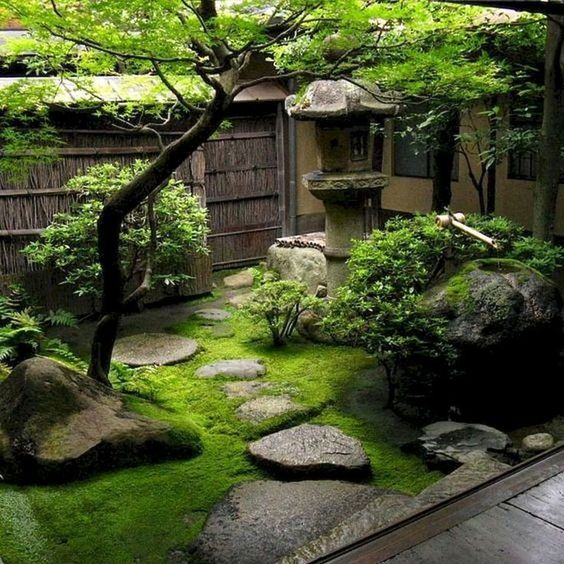
Source: Pinterest
Study garden
Most traditional study gardens have lanterns, often of the Kasuga style (Toro). The lights in question are supported by a single column. The enormous umbrella works well as a snow cape, catching the falling snow and presenting it as a fluffy white headpiece to anybody who cares to look.

Source: Pinterest
Strolling garden
Historical and fantastical settings from China and Japan are both often re-created in this kind of Japanese garden. These daimyo gardens were works of art that demonstrated the owner’s cultural sophistication and material success.

Source: Pinterest
Dry landscape garden
The water that characterises all other types of Japanese gardens is absent in dry landscape gardens. Gravel stands in for water to create the illusion of a dry river or ocean. The vacant space between stone groups in a dry landscape garden is a more true reflection of the competence of the designer than the stone arrangements themselves.
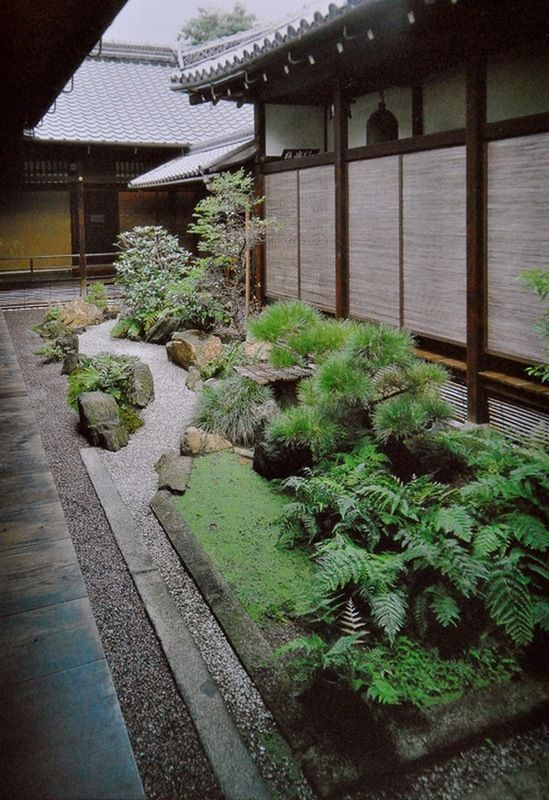
Source: Pinterest
Courtyard garden
Gardens in the interior courtyards of larger homes were important for more than just aesthetic reasons as a means of controlling the home’s temperature and ventilation during the long, hot summers. This was an area where several sorts of water elements, common in Japanese gardens, really shone.
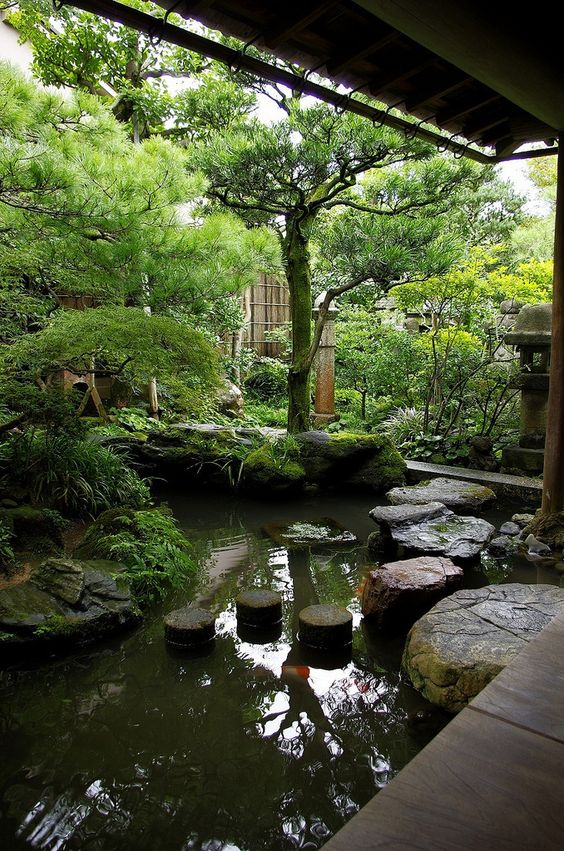
Source: Pinterest
Japanese garden: Principles
- Japan is one of the few countries in the world where the changing of the seasons has such a profound cultural impact on everyday life and the emotions and dispositions people experience. Therefore, it’s not hard to see why the changing of the seasons is so crucial to a garden.
- Selecting the greatest available materials is vital in developing any garden. Learn what resources are at your disposal before you dive in.
- Plants native to a certain region are used to create an environment that evokes that region, whether it be the mountains, a meadow, or the beach. Avoid using radically opposing leaf textures and colours in favour of a more harmonic combination of plants to create a landscape where no one component overpowers the others.
- A well-designed garden will feature landforms, vegetation, and paths that are all proportional to the human form. This gives the viewer a sense of familiarity with the site’s environment.
FAQs
How do you refer to a Japanese garden?
Some people call dry landscape gardens Zen gardens, although the correct term is karesansui. In Japan, Zen monasteries like Kyoto's world-famous Ryoan-ji have these kinds of gardens as part of their grounds.
What exactly is the idea behind a Japanese garden?
The gardens are often minimalist, including just evergreens, rocks, pebbles, sand, ponds, and waterfalls, eschewing the ornate flourishes that are common in many Western garden designs.
Which three things make up a Japanese garden?
Stone, which forms the framework of the landscape, water, which symbolises the life-giving power; and plants, which offer colour and change with the seasons, are the three basic materials utilised to make a Japanese garden.
| Got any questions or point of view on our article? We would love to hear from you.
Write to our Editor-in-Chief Jhumur Ghosh at [email protected] |
Housing News Desk is the news desk of leading online real estate portal, Housing.com. Housing News Desk focuses on a variety of topics such as real estate laws, taxes, current news, property trends, home loans, rentals, décor, green homes, home improvement, etc. The main objective of the news desk, is to cover the real estate sector from the perspective of providing information that is useful to the end-user.
Facebook: https://www.facebook.com/housing.com/
Twitter: https://twitter.com/Housing
Email: [email protected]


